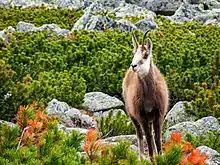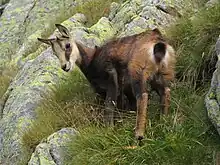Tatra chamois
The Tatra chamois (Rupicapra rupicapra tatrica; Slovak: Kamzík vrchovský tatranský; Polish: Kozica tatrzańska) is a subspecies of the chamois of the genus Rupicapra. Tatra chamois live in the Tatra Mountains in Slovakia and Poland.
| Tatra chamois | |
|---|---|
 | |
| Scientific classification | |
| Domain: | Eukaryota |
| Kingdom: | Animalia |
| Phylum: | Chordata |
| Class: | Mammalia |
| Order: | Artiodactyla |
| Family: | Bovidae |
| Subfamily: | Caprinae |
| Tribe: | Caprini |
| Genus: | Rupicapra |
| Species: | |
| Subspecies: | R. r. tatrica |
| Trinomial name | |
| Rupicapra rupicapra tatrica (Blahout, 1971/1972) | |

Population and distribution
The Tatra chamois live in all parts of the Tatras: West Tatras (Slovakia and Poland) and Eastern Tatras, which consist of the High Tatras (Slovakia and Poland) and the Belianske Tatras (Slovakia), all protected by national parks in both countries.
The population has undergone several troughs and peaks in known history, with the most noticeable troughs occurring during both world wars. The largest population in the 20th century was recorded in the year 1964, when as much as 940 individuals were counted in the Slovak region of the Tatras. Subsequently, the population declined steadily to the lowest recorded numbers in history at the end of the century. During the years 1999-2000 numbers dropped below 200 individuals, which is considered a critical population size for the long-term survival of the subspecies.
A 5-year programme to save the Tatra chamois started in 2001, focusing on preserving its environment - especially during the mating season - by strict regulation of tourism and suppression of poaching.[2] The population started to recover, and after some 10 years it even reached its highest numbers in recorded history.
As of 2006, the Slovak Tatra National Park was home to 371 chamois, of which 72 were lambs, and the Polish Tatra National Park was home to 117 chamois, of which 27 were lambs.[3] As of 2010, a population recovered to 841 chamois, of which 74 were lambs, 699 (57 lambs) in Slovakia and 142 (17 lambs) in Poland, which is near the peak of 1964.[4] The highest ever population was recorded in 2018, when 1,431 individuals were counted in Tatras.
| Year | 1997 | 1998 | 1999 | 2000 | ||||||
|---|---|---|---|---|---|---|---|---|---|---|
| Population | 352 | 200 | 162 | 160 | ||||||
| Year | 2001 | 2002 | 2003 | 2004 | 2005 | 2006 | 2007 | 2008 | 2009 | 2010 |
| Population | 205 | 333 | 345 | 422 | 486 | 488 | 532 | 701 | 720 | 841 |
| Year | 2011 | 2012 | 2013 | 2014 | 2015 | 2016 | 2017 | 2018 | 2019 | 2020 |
| Population | 929 | 1096 | 1186 | 1389 | 1345 | 1367 | 1263 | 1431 | 1367 | 983 |
| Year | 2021 | 2022 | ||||||||
| Population | 1095 | 1222 | ||||||||
Census results: [5] [6] [7] [8] [9] [10] [11] [12] [13] [14] [15] [16]
Introduction to the Low Tatras
Because of concerns about survivability in its native range, the Tatra chamois was also artificially introduced into the Low Tatras mountains, situated south of Tatras, between the years 1969 and 1976, to create a reserve population there. The introduction involved 30 individuals and was successful as the population grew to a stable 100-130 individuals.[17]
However, recent DNA studies have shown that the Low Tatras population crossbred with Alpine chamois migrating from the Fatra mountains and the Slovak Paradise National Park. The Low Tatra chamois are no longer considered pure and therefore cannot act as a reserve population for the Tatra chamois. The Alpine chamois were introduced into Slovakia for hunting purposes before the Tatra chamois were officially classified as a separate subspecies.[18]
References
- Anderwald, P.; Ambarli, H.; Avramov, S.; Ciach, M.; Corlatti, L.; Farkas, A.; Jovanovic, M.; Papaioannou, H.; Peters, W.; Sarasa, M.; Šprem, N.; Weinberg, P. & Willisch, C. (2020). "Rupicapra rupicapra". The IUCN Red List of Threatened Species. IUCN. 2020: e.T39255A22149561. doi:10.2305/IUCN.UK.2020-3.RLTS.T39255A22149561.en. S2CID 242186346. Retrieved 27 May 2022.
- "Program záchrany kamzíka vrchovského tatranského na roky 2001 - 2005" (in Slovak). 2001. Archived from the original on 2016-08-16. Retrieved 2016-07-21.
- "Kamzík tatranský vrchovský" (PDF) (in Slovak). Tatra National Park Administration. September 2006. Archived from the original (PDF) on March 24, 2012. Retrieved June 19, 2007.
- Libor Bolda (November 4, 2010). "Kamzíků je letos v Tatrách 841" [841 Chamois in Tatras this year] (in Czech).
- "Fauna Tatranského národného parku" (in Slovak). Tatra National Park Administration. 2008. Archived from the original on March 29, 2010. Retrieved January 19, 2009.
- "Autumn census 2012" (in Slovak). TANAP Administration. 31 October 2012.
- "Autumn census 2013" (in Slovak). TANAP Administration. 30 October 2013.
- "Autumn census 2014" (in Slovak). TANAP Administration. 28 October 2014.
- "Autumn census 2015" (in Slovak). TANAP Administration. 5 November 2015.
- "Autumn census 2016" (in Slovak). TANAP Administration. 8 November 2016. Archived from the original on 6 December 2017. Retrieved 19 November 2016.
- "Autumn census 2017" (in Slovak). TANAP Administration. 14 November 2017.
- "Autumn census 2018" (in Slovak). sme.sk. 2 November 2018.
- "Autumn census 2019" (in Slovak). TASR. 16 November 2019.
- "Autumn census 2020" (in Slovak). TANAP Administration. 5 November 2020.
- "Autumn census 2021" (in Slovak). TANAP Administration. 5 November 2021.
- "Autumn census 2022" (in Slovak). TANAP Administration. 7 November 2022.
- "Kamzík vrchovský tatranský (Rupicapra rupicapra tatrica)" (in Slovak). Low Tatras National Park Administration. 19 June 2007. Archived from the original on 23 June 2015. Retrieved 19 June 2007.
- "Nízkotatranské kamzíky už tatranského nezachránia" (in Slovak). Popradský Korzár. 19 October 2011.
External links
- IUCN Red List of Threatened Species: Rupicapra rupicapra tatrica (Tatra chamois) — Listed as Endangered (EN) B1+2ab.
